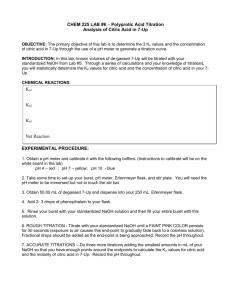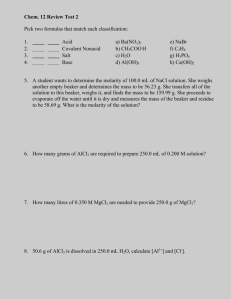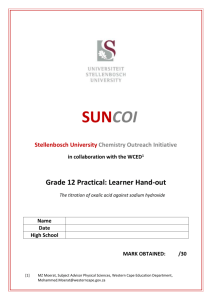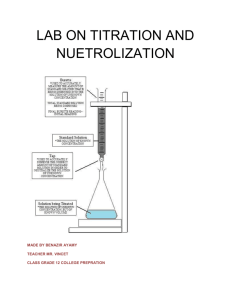Titration Lab: Citric Acid in Soda - Chemistry Worksheet
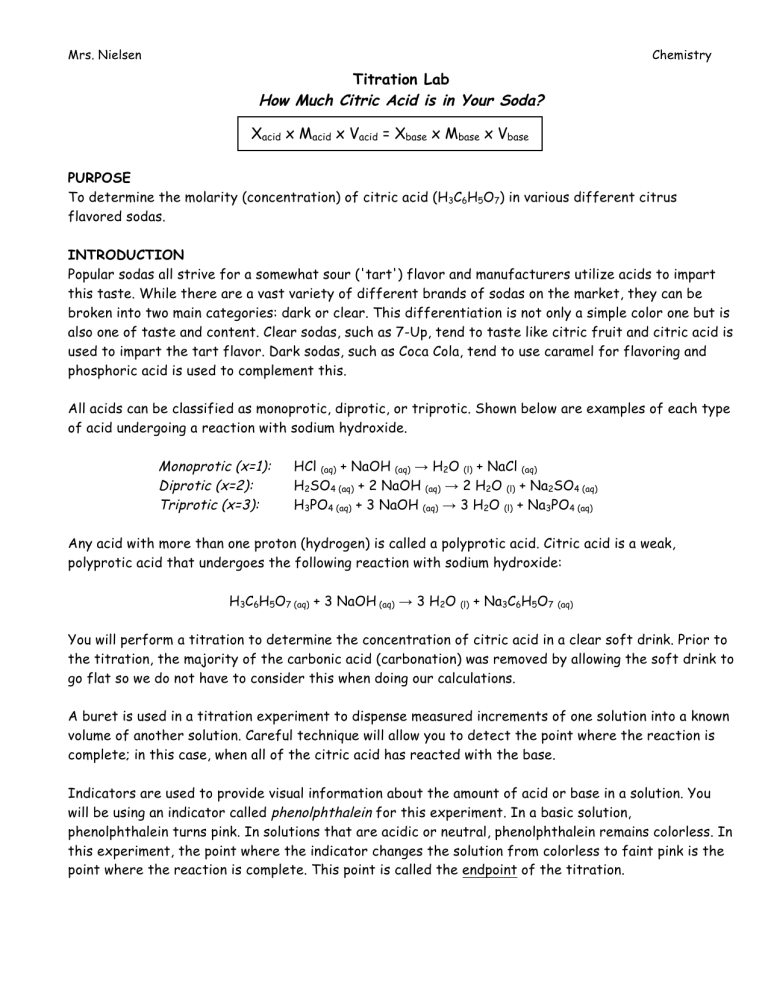
Mrs. Nielsen Chemistry
Titration Lab
X
How Much Citric Acid is in Your Soda?
acid
x M acid
x V acid
= X base
x M base
x V base
PURPOSE
To determine the molarity (concentration) of citric acid (H flavored sodas.
INTRODUCTION
3
C
6
H
5
O
7
) in various different citrus
Popular sodas all strive for a somewhat sour ('tart') flavor and manufacturers utilize acids to impart this taste. While there are a vast variety of different brands of sodas on the market, they can be broken into two main categories: dark or clear. This differentiation is not only a simple color one but is also one of taste and content. Clear sodas, such as 7-Up, tend to taste like citric fruit and citric acid is used to impart the tart flavor. Dark sodas, such as Coca Cola, tend to use caramel for flavoring and phosphoric acid is used to complement this.
All acids can be classified as monoprotic, diprotic, or triprotic. Shown below are examples of each type of acid undergoing a reaction with sodium hydroxide.
Monoprotic (x=1): HCl
(aq)
Diprotic (x=2): H
Triprotic (x=3): H
2
3
SO
PO
+ NaOH
(aq)
→
4 (aq)
+ 2 NaOH
4 (aq)
+ 3 NaOH
H
(aq)
(aq)
2
O
→
→
(l)
+ NaCl
(aq)
2 H
3 H
2
O
(l)
+ Na
2
O
(l)
+ Na
3
2
SO
PO
4 (aq)
4 (aq)
Any acid with more than one proton (hydrogen) is called a polyprotic acid. Citric acid is a weak, polyprotic acid that undergoes the following reaction with sodium hydroxide:
H
3
C
6
H
5
O
7 (aq)
+ 3 NaOH
(aq)
→ 3 H
2
O
(l)
+ Na
3
C
6
H
5
O
7 (aq)
You will perform a titration to determine the concentration of citric acid in a clear soft drink. Prior to the titration, the majority of the carbonic acid (carbonation) was removed by allowing the soft drink to go flat so we do not have to consider this when doing our calculations.
A buret is used in a titration experiment to dispense measured increments of one solution into a known volume of another solution. Careful technique will allow you to detect the point where the reaction is complete; in this case, when all of the citric acid has reacted with the base.
Indicators are used to provide visual information about the amount of acid or base in a solution. You will be using an indicator called phenolphthalein for this experiment. In a basic solution, phenolphthalein turns pink. In solutions that are acidic or neutral, phenolphthalein remains colorless. In this experiment, the point where the indicator changes the solution from colorless to faint pink is the point where the reaction is complete. This point is called the endpoint of the titration.
Mrs. Nielsen Chemistry
BACKGROUND KNOWLEDGE
1. Write & balance the neutralization equation you will be carrying out and label which is the acid, base, water, and salt.
2. Calculate the molar mass of citric acid. Show ALL work and include units! __________________
3. Practice Problem: You find that an average volume of 25.0 mL of 0.10 M NaOH is needed to neutralize 10.0 mL of 7-Up. Calculate the molarity of citric acid in the 7-Up. Show ALL work! (Hint:
Use the titration equation!)
MATERIALS
!
7-Up
!
Sprite
!
Squirt
!
0.10 M NaOH
!
!
!
!
burette clamp
250-mL Erlenmeyer flask
DI water
Funnel
!
Phenolphthalein !
10-mL graduated cylinder
!
50-mL burette
PROCEDURE
SAFETY: Write a bulleted list of safety precautions that must be taken when working with acids and bases.
PROTOCOL:
1.
Rinse the burette with DI water to make sure it is cleaned thoroughly prior to the titration.
2.
Fill the burette with 0.10 M NaOH and record the initial volume of NaOH.
3.
Pour exactly 10.0 mL of your group’s assigned soda into a 250 mL Erlenmeyer flask. Add 2 drops of phenolphthalein to the soda and swirl the flask to mix the contents.
4.
Slowly add NaOH drop-wise to the soda until a faint pink color is obtained. (Place the flask on white paper to help see the color change better). Swirl the flask until the pink color remains for at least 10 seconds.
5.
Record your final volume of NaOH.
6.
Pour the contents of your flask down the sink and rinse with tap water.
7.
Repeat steps 2-5 two additional times.
8.
Calculate the total volume of NaOH used in each trial by finding the difference between your initial and final burette readings.
9.
Calculate the average volume of NaOH used for the three trials and record your group’s data on the board.
10.
Drain your burette and rinse with DI water. Clean your lab station and replace all equipment.
OBSERVATIONS: List any qualitative observations that you make during the lab activity.
Mrs. Nielsen
DATA
Chemistry
Trial
Initial burette reading,
NaOH (mL)
Volume of NaOH
Final burette reading,
NaOH (mL)
Total Volume of NaOH
Used (mL)
1
2
3
Average Volume of NaOH: _____________________
Brand of Soda
Class Data
Average volume of NaOH needed for neutralization (mL)
Average mass of citric acid per 2-L bottle of soda (g)
DATA PROCESSING: In order to receive credit, you must show ALL necessary work.
1. Use the titration equation to find the molarity of citric acid contained in each sample of soda.
2. Use the molarity of citric acid to calculate the moles of citric acid contained in your 10-mL sample of soda.
3. Use the molarity of citric acid to find the moles of citric acid contained in a 2-L bottle of each soda.
4. Use the mole highway to find the grams of citric acid per 2-L bottle of each soda. Record this mass in your class data table.
Mrs. Nielsen Chemistry
DISCUSSION QUESTIONS
1. Rank the sodas used in the experiment in order from least to greatest citric acid content.
2. Why was it necessary to degas the sodas prior to the experiment?
3. Why do you think dentists warn people against drinking too much soda?
CONCLUSION AND EVALUATION: Write 2 paragraphs that fully explain your results according to the following guidelines:
!
Paragraph 1: o Begin with a topic sentence that refers to the purpose of your lab. o State the significant quantitative data -- summarize the results o Next refer to your background information and explain why that happened and/or tell what you infer from the data -- What does the data tell you? o End this paragraph with a concluding sentence that tells what you learned.
!
Paragraph 2: o Discuss the likely sources of error or limitations in your experiment o How did these errors affect your results? Be very specific to your lab experience. o Provide specific, reasonable recommendations that would improve your result. o What further experiments would you like to conduct to further your understanding of this phenomenon/scientific process?

